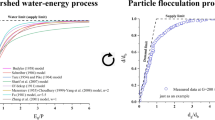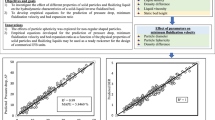Abstract
Fluidized bed bioreactors are widely used in wastewater treatment applications. Such reactors employ gel beads or hard particles covered with a biofilm layer. These particles lose more energy due to deformation when they collide than particles with high mechanical resistance. This energy loss can result in heterogeneity in particle distribution, increasing the drag on them, which, if not considered properly, can lead to problems in reactor design and operation. Therefore, it is important to know how much energy is dissipated by particles with low mechanical strength during collisions. In this context, the coefficient of restitution of alginate particles synthesized using different cationic solutions was determined experimentally. The influence of the Young’s modulus, size and roughness of the particles, as well as the impact velocity, on the coefficient of restitution was investigated. Results indicate that the coefficient of restitution is directly proportional to the particle Young's modulus and inversely proportional to the impact velocity. A correlation is proposed to estimate the coefficient of restitution as a function of particle density, Young’s modulus, impact velocity and maximum deformation in the elastic regime, with R2 = 0.9219. This correlation provides a potential tool for determining the coefficient of restitution to be used in simulating the dynamics of the flow in fluidized bed bioreactors in wastewater treatment.
Graphic abstract






Similar content being viewed by others

Data availability
The data presented in the article are available in the public repository of the Federal University of São Carlos, at the website https://repositorio.ufscar.br/handle/ufscar/12660.
Abbreviations
- c 0 :
-
Compressional wave velocity (m/s)
- d:
-
Particle diameter (m)
- e :
-
Coefficient of restitution (-)
- E :
-
Young’s modulus (Pa)
- R a :
-
Average roughness (μm)
- V 1 :
-
Impact velocity (m/s)
- εmax :
-
Maximum deformation of particles in the elastic regime (-)
- ρ:
-
Particle density (kg/m3)
- σ:
-
Standard deviation (units as required
References
Aryaei A, Hashemnia K, Jafarpur K (2010) Experimental and numerical study of ball size effect on restitution coefficient in low velocity impacts. Int J Impact Eng 37:1037–1044. https://doi.org/10.1016/j.ijimpeng.2010.04.005
Cecconet D, Callegari A, Hlavínek P, Capodaglio AG (2019) Membrane bioreactors for sustainable, fit-for-purpose greywater treatment: a critical review. Clean Technol Environ Policy 21:745–762. https://doi.org/10.1007/s10098-019-01679-z
Chandrashekhar B, Pandey RA (2017) Experimental and modelling study of treatment and regeneration of ferrous-nitrilotriacetate solution scrubbed with nitric oxide by an up-flow anaerobic biofilm reactor. J Clean Prod 155:179–188. https://doi.org/10.1016/j.jclepro.2016.09.013
Ghanbarzadeh A, Hassanpour A, Neville A (2019) A numerical model for calculation of the restitution coefficient of elastic-perfectly plastic and adhesive bodies with rough surfaces. Powder Technol 345:203–212. https://doi.org/10.1016/j.powtec.2018.12.079
Harper BA, Barbut S, Lim LT, Marcone MF (2014) Effect of various gelling cations on the physical properties of “wet” alginate films. J Food Sci 79:562–567. https://doi.org/10.1111/1750-3841.12376
Horabik J, Beczek M, Mazur R et al (2017) Determination of the restitution coefficient of seeds and coefficients of visco-elastic Hertz contact models for DEM simulations. Biosyst Eng 161:106–119. https://doi.org/10.1016/j.biosystemseng.2017.06.009
Igathinathane C, Melin S, Sokhansanj S et al (2009) Machine vision based particle size and size distribution determination of airborne dust particles of wood and bark pellets. Powder Technol 196:202–212. https://doi.org/10.1016/j.powtec.2009.07.024
Jayashree S, Ramesh ST, Lavanya A et al (2019) Wastewater treatment by microbial fuel cell coupled with peroxicoagulation process. Clean Technol Environ Policy 21:2033–2045. https://doi.org/10.1007/s10098-019-01759-0
Leroy B (1985) Collision between two balls accompanied by deformation: a qualitative approach to Hertz’s theory. Am J Phys 53:346–349. https://doi.org/10.1119/1.14164
Li X, Dong M, Jiang D et al (2020) The effect of surface roughness on normal restitution coefficient, adhesion force and friction coefficient of the particle-wall collision. Powder Technol 362:17–25. https://doi.org/10.1016/j.powtec.2019.11.120
Liberman N, Shandalov S, Forgacs C et al (2016) Use of MBR to sustain active biomass for treatment of low organic load grey water. Clean Technol Environ Policy 18:1219–1224. https://doi.org/10.1007/s10098-016-1112-4
Lopes GC, Bi X, Epstein N et al (2018) Hydrodynamic characteristics of particles with different roughness and deformability in a liquid fluidized bed. Chem Eng Sci 185:50–63. https://doi.org/10.1016/j.ces.2018.03.058
Metolina P, Lopes GC (2019) Numerical analysis of liquid-solid flow in tapered and cylindrical fluidized beds for wastewater treatment and biogas production. Energy Convers Manag 187:447–458. https://doi.org/10.1016/j.enconman.2019.02.092
Mueller P, Boettcher R, Russell A et al (2015) A novel approach to evaluate the elastic impact of spheres on thin plates. Chem Eng Sci 138:689–697. https://doi.org/10.1016/j.ces.2015.08.056
Ngian K-F, Martin WRB (1980) Bed expansion characteristics of liquid fluidized particles with attached microbial growth. Biotechnol Bioeng 22:1843–1856. https://doi.org/10.1002/bit.260220906
Ouwerx C, Velings N, Mestdagh MM, Axelos MAV (1998) Physico-chemical properties and rheology of alginate gel beads formed with various divalent cations. Polym Gels Networks 6:393–408. https://doi.org/10.1016/S0966-7822(98)00035-5
Puguan JMC, Yu X, Kim H (2014) Characterization of structure, physico-chemical properties and diffusion behavior of Ca-Alginate gel beads prepared by different gelation methods. J Colloid Interface Sci 432:109–116. https://doi.org/10.1016/j.jcis.2014.06.048
Roy U, Das P, Bhowal A (2019) Treatment of azo dye (congo red) solution in fluidized bed bioreactor with simultaneous approach of adsorption coupled with biodegradation: optimization by response surface methodology and toxicity assay. Clean Technol Environ Policy 21:1675–1686. https://doi.org/10.1007/s10098-019-01736-7
Stronge WJ, Sofi AR, Ravani B (2019) Computing the composite coefficient of restitution for inelastic impact of dissimilar bodies. Int J Impact Eng 133:103333. https://doi.org/10.1016/j.ijimpeng.2019.103333
Wang L, Zheng Z, Yu Y et al (2020) Determination of the energetic coefficient of restitution of maize grain based on laboratory experiments and DEM simulations. Powder Technol 362:645–658. https://doi.org/10.1016/j.powtec.2019.12.024
Weir G, Tallon S (2005) The coefficient of restitution for normal incident, low velocity particle impacts. Chem Eng Sci 60:3637–3647. https://doi.org/10.1016/j.ces.2005.01.040
Yardeny I, Portnikov D, Kalman H (2020) Experimental investigation of the coefficient of restitution of particles colliding with surfaces in air and water. Adv Powder Technol 31:3747–3759. https://doi.org/10.1016/j.apt.2020.07.018
Zhou J, Xia K, Liu X et al (2021) Utilization of cationic polymer-modified fly ash for dye wastewater treatment. Clean Technol Environ Policy. https://doi.org/10.1007/s10098-020-02019-2
Funding
This study was financed in part by the Coordenação de Aperfeiçoamento de Pessoal de Nível Superior—Brasil (CAPES)—Finance Code 001, and Fundação de Amparo à Pesquisa do Estado de São Paulo (FAPESP, processes n° 2018/16036–8 and 2018/20711–2).
Author information
Authors and Affiliations
Contributions
All authors contributed to the manuscript conception. The experimental steps, such as material preparation, experimental collision tests and data analysis, were carried out by KRBM. All steps were supervised by GCL, the project coordinator. JRG contributed to the definition of the project and helped in discussing the results. All authors commented and contributed to previous versions of the article. All authors read and approved the final manuscript.
Corresponding author
Ethics declarations
Conflict of interest
The authors declare that they have no conflict of interest.
Additional information
Publisher's Note
Springer Nature remains neutral with regard to jurisdictional claims in published maps and institutional affiliations.
Rights and permissions
About this article
Cite this article
Melo, K.R.B., Grace, J.R. & Lopes, G.C. A new correlation for the coefficient of restitution of particles with low mechanical resistance for modeling wastewater treatment biofilm reactors. Clean Techn Environ Policy 24, 623–632 (2022). https://doi.org/10.1007/s10098-021-02079-y
Received:
Accepted:
Published:
Issue Date:
DOI: https://doi.org/10.1007/s10098-021-02079-y



